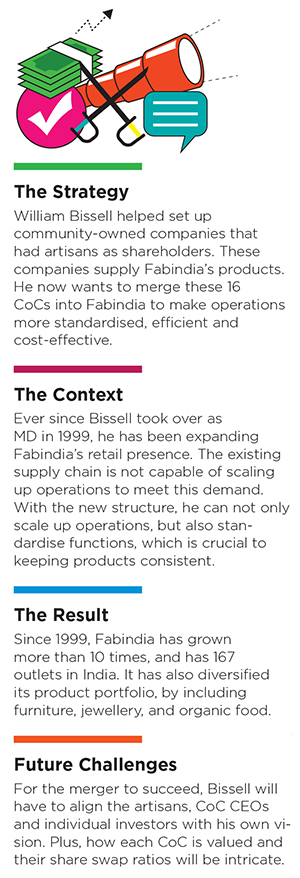
William Bissell: Turning Fabindia's Artisans to Company Owners
Award: Entrepreneur with Social Impact
Name: William Bissell, Managing Director, Fabindia
Age: 46
Why He Won: For creating a globally recognised, profitable retail brand that has over 22,000 local artisans as its shareholders, most of whom would have lost their livelihoods if it were not for Bissell and Fabindia. And being able to make sure margins are almost three times that of the industry average.
William Bissell never had to persuade anyone to buy Fabindia products. The clothes, furniture and upholstery pretty much sell themselves.
But now, Bissell is about to embark on his toughest persuasion task: He has to coax his 16 supplier companies to merge with Fabindia.
“In two to three years, all our employees and suppliers will be shareholders in Fabindia,” says Bissell, managing director of the iconic brand. No, he is not talking about giving his employees and suppliers (and thus the artisans) an option to buy shares through the much-awaited IPO. That will surely come.
But before that Bissell, who firmly believes business can be the biggest force of social change, wants to merge each supplier company—called community owned company or CoC, these are co-owned by artisans, much like a co-operative—with Fabindia. This will make each CoC shareholder, including artisans, owners of Fabindia’s equity. The retail company’s microfinance unit AMFPL holds a strategic stake in each of these supplier firms.
This will perhaps be one of the most audacious mergers in corporate India. Imagine deciding the share swap ratio between each of the CoCs and Fabindia, which owns the brand, the customer experience and the retail outlets.
Bissell has had some basic communication with the CoCs and their investors, telling them “this is going to be the new system… It will continue to be inclusive like the earlier one and it will be good to have all of you on board.” The intricacies of how each CoC will be valued, and what their share swap ratios will be, are yet to be even discussed.
The merger is perhaps the most important step in the history of Fabindia. With this Bissell’s creation will stop looking like a match between a market-loving rake (Fabindia), and its 16 socialistic brides (the CoCs). Fabindia will become a normal limited company, like Tata Steel or Wipro.
But this does not suggest that Bissell won’t have the artisans’ interest in mind anymore. In reality, the artisans will now have direct claim over all of Fabindia’s profits—through their equity—and not just the profits of the CoCs. Their and Bissell’s interests will be aligned more tightly than before.
Mixed Reactions
The move is bound to upset a lot of people. For many in the social sector, Fabindia was a gateway through which the profits from the rich found their way to poor and deserving artisans.
CoCs were small, and were rooted in the local geography. They were sustainable. That was the vision of William’s father John, when he set up Fabindia in 1960. The company never made the products it sold.
With the merger, it will become a completely integrated company that will source raw materials, make finished products out of them, and sell them through outlets across the country.
There will be suggestions about how William has moved away from John’s vision. “William is keeping true to his father’s vision of creating jobs in rural India. And it is a win-win proposition,” says Sunil Chainani, Fabindia’s executive director and Bissell’s mentor.
While the merger will enable Fabindia to add the margins of CoCs to its books, it will allow artisans to have a share in the value-add that their products get from consumers at the outlets.
Bissell has the backing of his new investors L Capital and Premji Invest, who he selected over eight other suitors early this year. “That [the merger] is something that all of us would like to happen,” says Sanjay Gujral, regional managing director, L Capital Asia, a unit of the private equity arm of French fashion major LVMH that bought 8 percent of Fabindia earlier this year.
Why it Must Be Done
While all this may sound like investor-speak, reality is that Fabindia’s hybrid approach has run its course. There is a clear chasm opening between the potential of consumer-facing Fabindia and the ability of its supplier companies.
Fabindia currently generates sales of Rs 500 crore a year and its plan, according to internal sources, is to take this to Rs 1,000 crore in the next four years. Right now, Fabindia has 167 stores and it plans to add 25 to 30 outlets every year, many of them in smaller cities.
The old way worked till now because Bissell made artisans shareholders in the CoCs. Not only did they get more regular jobs, they also got dividends. “These were the two biggest gains for artisans,” says Chainani.
The move also created entrepreneurs. Supplier companies were able to attract investment from outside, from the likes of Aavishkaar. With Fabindia’s hand-holding, the suppliers developed capacities. For instance, some of them were beginning to centralise some of the functions, like buying, to improve standardisation. “Without the suppliers,” says Rai, “Fabindia would not have been able to get to the next level, which is the merger.”
Scaling up: The present supply chain and supplier companies are not equipped to handle the increase in revenue. At any given point of time, Fabindia has 2.5 lakh product variants (called stock keeping units or SKUs). While some of them can be produced quickly, the more sophisticated ones, such as silk garments, can take more than six months to be delivered, says Charu Sharma, CEO, Fabindia. Also, with the network of suppliers spread across the country, a garment sometimes travels across four locations before it is completed and is ready to be delivered to Fabindia.
Standardisation: The company is known to be flexible on deliveries, but strict on quality and consistency. With suppliers often competing with each other for the final nod and order from Bissell’s team, standardisation of products is a challenge. Rai says the problem is compounded by the fact that the same garment could be made by an artisan in the hills or one by the coast. “Different cultures, working conditions, and lack of awareness about the taste of urban consumers make it tough,” he says.
Some of these inefficiencies—especially delivery time—were proving to be difficult to manage, and that affected the product’s time-to-market schedule. While standardisation has been on, it is yet to be completed. Even Rangasutra, one of the larger CoCs, which has been faster than others to scale and standardise, says there is a limit to what it can do on its own.
Chainani says achieving this is very important. “Customers might buy a hand-made product once because it is a good thing to do. But for them to like it, and come again and keep buying it, the product has to be good.”

Ideally, they should be able to raise more capital, but it is difficult. Though the workers are shareholders, there is not much liquidity for them. “Pricing was a problem for investors and artisans. It was not easy to exit if anyone wanted to monetise their investment,” says Rai. In any case, there would not be many external investors willing to put money into a company that is largely a captive supplier of just one brand, Fabindia.
One of the CoCs in Faridabad shut down. Two others, in Bhuj and Bijnour, have merged with their bigger cousins to save costs through economies of scale and simpler logistics. “The Bijnour CoC used to supply garments to Dilli Karigari, which is the biggest manufacturer among CoCs. After it merged with the latter, a middleman was avoided, leading to faster deliveries and better efficiency,” says Shaila Tyagi, an old Fabindia hand, and now the managing director of Dilli Karigari.
The whole system needs to work with clockwork precision, otherwise “you run the risk of going into discounts and sales, which is the lazy way of handling your inventories,” says Bissell. Fabindia, much to the dismay of its regulars looking for bargain buys, has successfully limited its discount sales to 3 percent of inventories.
Push for Organic: The new system is crucial for Bissell’s ambitions for the organic food business. The segment contributes only 5 percent to Fabindia’s turnover, but is the fastest growing, at 40 percent a year. The present supply chain might struggle to meet Bissell’s targets: Exclusive organic food outlets; selling under the Fabindia brand in supermarkets, a first for the company; selling fresh organic vegetables and fruits.
Taxes: The last nail in the coffin of the old supply chain was dealt by the taxman. The Union Budget of 2012 introduced transfer pricing guideline that hit Fabindia hard. “To have 2.5 lakh SKUs and with each product changing hands multiple times between NGOs [who would be working for CoCs], supplier companies and Fabindia, transfer pricing can become a nightmare,” said a senior Fabindia official.
Bissell knows he has to take all the artisans onboard for this merger. At present, almost 40,000 artisans work for the 16 CoCs. Though every one of them is not a shareholder in the CoCs right now, it is an option that is open to all of them. “That will be revolutionary,” says Bissell of the eventual vision of each artisan becoming a shareholder.
Key to the success of the merger would be aligning CoC shareholders (including the artisans), CEOs and individual investors like Vineet Rai of Aavishkaar with Bissell’s own vision. Can he convince them?
Rai, who remains an investor in two such companies after divesting his stake in one earlier this year at 37 percent margin, is convinced of Bissell’s rationale. “We need to see what the structure of the merger will be,” he said. In other words, the valuation of the CoCs, and thus the share swap ratio, would be decisive. At present, all of these companies are “operationally profitable, though two have accumulated losses,” Fabindia said in an emailed reply.
Some people fear that the supplier companies will lose their individuality. Rangasutra, for instance, has decided to opt out of the merger, although it will continue to supply to Fabindia. But Rangasutra might be the only exception. Others are expected to agree with Bissell.
For someone who is known to be a tough negotiator but also charming and persuasive, Bissell has successfully shared his vision with artisans in the past. Ghosh, of Rangasutra, recounts how Bissell sat down with artisans to make them understand why becoming a shareholder benefits them.
“Business can be the biggest force of social change and can bring about that change for good,” says the 46-year-old, who has also proved to be a good businessman. Even if it comes at the cost of Leftist idealism.
(This story appears in the 12 October, 2012 issue of Forbes India. To visit our Archives, click here.)















